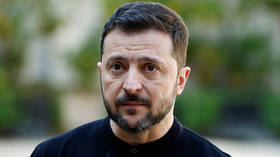'US police union 'blue wall of silence' protects abusive cops but damages public trust'
Increasingly, many US citizens are having difficulty seeing a difference between so-called good police officers and so-called bad police officers, Gerald Horne, author and historian, told RT. Former police officer, Michael Wood, also joins the discussion.
A man was shot down and killed in a police chase in Milwaukee on Saturday, which led to rioters setting several vehicles ablaze, as well as a gas station and numerous businesses.
The Milwaukee Police Department stated that the fire department was initially unable to put out a blaze at a gas station due to sporadic shooting at the site.
A few days before the incident, the US Department of Justice released a report that revealed that the Baltimore Police Department were unconstitutionally practicing violence towards African-Americans, including the use of force against minors and people with disabilities.
Gerald Horne, author and historian
RT: We now know that at least five businesses were torched, many of those also looted. Won’t these actions just move attention away from what these individuals are protesting?
Gerald Horne: No, I am afraid not. It brings attention, including global attention, which is absolutely necessary to what the protesters are seeking to achieve. Recall, just a few days ago the US Department of Justice released a report about the Baltimore Police, which suggests that this department has been engaged in a reign of terror against its black residents for years now.
Just a few days ago, The New York Times had a front page story about the scandal in the medical community showing that doctors and nurses are reluctant to prescribe pain killers to black patients – they basically are oblivious literally to the pain that black patients endure. Given such a situation, the protesters feel they have no alternative but to take to the streets.
RT: Isn’t there a danger that in this particular situation people may be reacting slightly prematurely? We have very little information about the suspect, about the situation in which he died. Isn’t there still the possibility that this may have been a justified shooting?
GH: A faint possibility at best. We know that in Milwaukee for years now there have been justifiable and persistent complaints from the African-American community about mishandling, about roughhouse tactics by the police department. What happened last night is totally consistent with yet another police shooting. Recall that we’ve become almost inure to the kinds of terror that is inflicted upon black people in the USA. It seems that every other day there is a video of a black person being shot down by the police. Given that context the protests that are taking place in Milwaukee are wholly and totally understandable.
RT: Police seem to be under intense pressure now, no matter what they do. Are officers across the US paying for those embroiled in accusations of brutality?
GH: Well, first of all there is a real problem with police unions, which engage in what is routinely called a ‘blue wall of silence.’ That is to say the so-called good apples - or police officers who are not involved in brutality - refuse to testify against police officers, who have justifiable reputations for brutality and racism. Until that ‘blue wall of silence’ begins to crumble, it is understandable why protesters tend to see no difference between so-called good police officers and so-called bad police officers.
Michael A. Wood Jr., former police officer, Baltimore
RT: What’s your take on the report released by the Department of Justice?
Michael A. Wood Jr.: It seems like the DOJ report is something that everybody is pointing to right now, as essentially something because it has a signature attached to it and it has the letterhead of the DOJ. But this reads like a statement from a 100 years ago, 50 years ago, 20 years ago from the Black community in Baltimore, mainly Black, but Black and poor communities of east and west Baltimore. So it is the same story they have been telling. It is the same story that I came out telling you – it reads like a transcript from interviews with me from two years ago. We have the rape issues and sexual offense issues that were already issues in Baltimore that got the national scene a couple of years ago. So this is vindication in an official form, but this is nothing that people don’t already know. This isn’t something I‘ve already complained about multiple times, just verifying the same things in everybody’s neighborhoods have been saying.
RT: Which organizations, do you think, mostly are trying to tackle this unjustified violence committed by many US police departments?
MW: I think it is all with the entire Black Lives Matters movement and some of the other broader more socialist-minded movements that are going on in the youth in America. There is a transformation away from the lack of information and buying into media into more of the internet and free sharing of information. And with that come these videos, and it comes broader minds, where people can now see and share things. Freddie Gray was the fourth victim in the back of a van that was killed by Baltimore or severely injured. Freddie was a second killed, and there were two that were paralyzed in just recent times in Baltimore for being in the back of a van. So it is just because it is a part of the whole movement; at this time you got a bigger spotlight.
RT: Do you think it is just a Baltimore issue, or is it much broader than that?
MW: I don’t think by any means this is specifically a Baltimore issue. This is more of a theme in the hyper-segregated cities in America than everywhere else. These DOJ reports from St. Louis, from Ferguson, from Cleveland, and from New Orleans – they are all ring of the same tone and the same findings. The number one issue involves the drug war, which pits the police officers against the community. So there is no other way if you have a war on people, where people perceive like there is a war being put on them. And then we have implicit bias, when normal human activity is criminalized, then that gives the power for implicit bias to come out, and there is an ‘us versus them’ mentality. And that is why in America traditionally you have this punishment of pushing down and blaming people that have less of an opportunity than you. That is an old thing in America. But we’re pushing back against it – so you’re seeing that pushback.
The statements, views and opinions expressed in this column are solely those of the author and do not necessarily represent those of RT.














